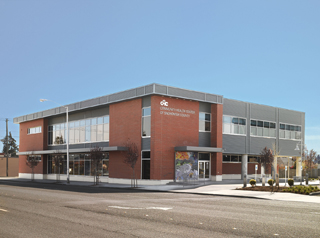|
Subscribe / Renew |
|
|
Contact Us |
|
| ► Subscribe to our Free Weekly Newsletter | |
| home | Welcome, sign in or click here to subscribe. | login |
Environment
| |
 |
September 29, 2011
Everett clinic takes a shine to LEED silver
Brightworks Sustainability Advisors

Green
|
Developing a LEED silver-certified community health center may appear to be an extra indulgence atypical of nonprofit community health centers across the U.S. due to additional costs associated with the LEED process. For Community Health Center of Snohomish County’s Broadway clinic, LEED certification aligned well with the project’s goals to improve energy efficiency, decrease energy costs and create a healthy indoor environment.
The Community Health Center of Broadway is a 19,000-square-foot medical and dental clinic in Everett. With an added cost of about $100,000, the LEED certification effort was less than 1 percent of the overall project cost.
Even that 1 percent will be quickly paid back with ongoing savings in utility bills and a healthier environment for staff and patients that increases staff retention and reduces absenteeism.
Performance and savings
The top reason building owners and developers choose to pursue LEED certification on their facilities is because the rating system provides a comprehensive set of design and construction strategies that are evaluated by a third party. This added rigor ensures that green design strategies are carried through to construction, and don’t get lost in the process.
Medical facilities use a much greater amount of energy than most other building types, so putting rigor around how they are designed and constructed for efficiency is significantly relevant. Medical facilities also typically have a longer life span than retail or office buildings, so these facilities can’t overlook the need for higher performance.
CHC found additional benefits beyond energy cost savings and longevity.
“CHC took certain steps leading to improved energy efficiency — higher R-values, low-flow plumbing fixtures, more window space for more natural light — which not only affect the operational costs but the maintenance costs as well. Less wear and tear of the equipment and fixtures,” says Brent Ediger, CHC facilities coordinator. “It has me thinking about what types of measures we can introduce in our other clinics and use on any future projects.”
Based on modeling results, energy savings results in approximately $4,500 per year based on today’s energy costs. Water savings are estimated to be approximately 90,000 gallons per year.
Healthy environment
| CHC Broadway project team |
|
Community Health Centers of Snohomish County Sustainability advisor: Brightworks General contractor: Abbott Construction Architect: Giffin Bolte Jurgens Civil engineer: Dowl HKM Structural engineer: PCS Structural Solutions HVAC&R design-build: Holaday-Parks Electrical design-build: R. Martin Electric Commissioning agent: FSI Engineers Energy modeler: Glumac Engineering |
Studies indicate that the green design features of a LEED-certified building can increase employee productivity by as much as 15 percent by increasing access to daylight and improving indoor air quality by using low-VOC materials and increased air filtration.
An article in Harvard Business Review by Charles Lockwood titled “Building the Green Way” has some compelling statistics on how productivity improvements impact the bottom line. If an organization’s largest cost is its employees (75 percent is a national average) than even a slight 2 percent improvement in productivity and reduced absenteeism can equate to thousands of dollars or more in payroll savings every year.
These savings can add up quickly, even for a small building like a community health center.
Prioritizing access to views, daylight and using low-VOC finishes has already yielded anecdotal benefits for CHC Broadway.
“The patients and staff love all the windows and the light they let in — even on our gray days it is so much more cheery and bright,” says Lisa Miller, CHC medical practice manager.
CHC is tracking energy and water performance in Energy Star Portfolio Manager to continue to learn from the ongoing performance of the building. Looking ahead, they will use the lessons and success of this LEED certification to inform which strategies they use on future medical facilities.
Jessica Green is the Seattle regional director for Brightworks Sustainability Advisors. This article was collaboratively written by Brightworks and Abbott Construction to help medical clients understand how sustainability programs can reduce operating costs, mitigate risk and enhance asset value.
Other Stories:
- Sixth Place Apartments are first in energy efficiency
- Putting a price on environmental damage
- Tacoma revitalizes itself, from the ground down
- It’s not all waste — fueling our future energy needs
- Our changing climate can be a job generator
- Floodplain management: the Rx for flood pains
- Indoor air problems may be coming from below
- Urban areas scale up for EcoDistricts
- Getting to net zero with SIP panels



